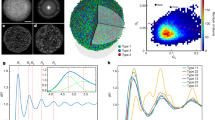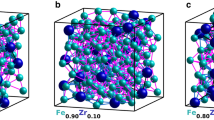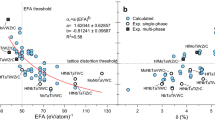Abstract
The idea that a material exhibiting broad diffraction halos does not have a characteristic amorphous structure but is just an assembly of randomly orientated microcrystals is a remarkably resilient one. Invariably it is resurrected when a new type of amorphous material is discovered, only to be put aside in most cases in favour of a truly amorphous structure (one without any lattice periodicity). For fused silica and the amorphous elemental semiconductors, this structure is the continuous random network1; for the amorphous metals it is a dense random packing of hard spheres (see ref. 2; the strong short-range order in amorphous metals is explicitly taken into account in the 'stereochemically defined9 models described in ref. 3). Nonetheless, truly microcrys-talline materials do exist, and their diffraction patterns consist of broadened powder peaks4. Here we show that these microcrystalline materials can be identified unambiguously by the characteristic isothermal calorimetric signal associated with their transformation to a large-grained material, and we use this test to demonstrate that two sputtered "amorphous' aluminum/transition metal alloys have a micro-quasicrystalline structure.
This is a preview of subscription content, access via your institution
Access options
Subscribe to this journal
Receive 51 print issues and online access
$199.00 per year
only $3.90 per issue
Buy this article
- Purchase on Springer Link
- Instant access to full article PDF
Prices may be subject to local taxes which are calculated during checkout
Similar content being viewed by others
References
Wright, A. C. J. non-Cryst. Solids 75, 15–27 (1985).
Cargill III, G. S. Solid St. Phys. 30 (eds Ehrenreich, H., Seitz, F. & Turnbull, D.), 227–320 (Academic, New York, 1975).
Gaskell, P. H. in Glassy Metals II; Topics in Applied Physics 53, 5–29 (Springer, Berlin, 1983).
Wagner, C. N. J., Light, T. B., Halder, N. C. & Lukens, W. E., J. appl. Phys. 39, 3690–3693 (1968).
Bendersky, L. A. & Ridder, D. J. Mater. Res. 1, 405–414 (1986).
Robertson, J. L., Moss, S. C. & Kreider, K. G. Phys. Rev. Lett. 60, 2062–2065 (1988).
Christian, J. W. The Theory of Transformations in Metals and Alloys 2nd edn, 525–548 (Pergamon, Oxford, 1975).
Henderson, D. W. J. non-Cryst. Solids 30, 301–315 (1979).
Greer, A. L. Acta metall. 30, 171–192 (1982).
Atkinson, H. V. Acta metall. 36, 469–491 (1988).
Thompson, C. V., Frost, H. J. & Spaepen, F. Acta metall. 35, 887–890 (1987).
Gleiter, H. & Chalmers, B. Prog. Mater. Sci. 16, 13–42 (1972).
Kissinger, H. E. Anal. Chem. 29, 1702–1706 (1957).
Author information
Authors and Affiliations
Rights and permissions
About this article
Cite this article
Chen, L., Spaepen, F. Calorimetric evidence for the micro-quasicrystalline structure of 'amorphous' Al/transition metal alloys. Nature 336, 366–368 (1988). https://doi.org/10.1038/336366a0
Received:
Accepted:
Issue Date:
DOI: https://doi.org/10.1038/336366a0
This article is cited by
-
Comprehensive thermal analysis of a high stability Cu–Zr–Al bulk metallic glass subjected to high-pressure torsion
Journal of Thermal Analysis and Calorimetry (2023)
-
Three-dimensional atomic packing in amorphous solids with liquid-like structure
Nature Materials (2022)
-
Isothermal Crystallization Kinetics of Cr-Rich Metallic Glass Cr29.4Fe29.4Mo14.7C14.7B9.8Y2 with Promising Properties
Transactions of the Indian Institute of Metals (2022)
-
Improvement of Thermoplastic Forming Ability of Ti–Zr–Ni–Cu Metallic Glass by Addition of Sn
Metals and Materials International (2021)
-
Low-temperature thermoplastic welding of metallic glass ribbons for in-space manufacturing
Science China Materials (2021)
Comments
By submitting a comment you agree to abide by our Terms and Community Guidelines. If you find something abusive or that does not comply with our terms or guidelines please flag it as inappropriate.



